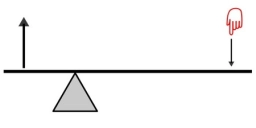The balance - the lever
For the lever to be balanced, the arms' lengths must be inversely proportional to the weight ratio of the weights suspended on these arms. Complete the data: 30 cm, 10 cm, 4 kg, and m2 kg.
Final Answer:

Tips for related online calculators
Check out our ratio calculator.
You need to know the following knowledge to solve this word math problem:
basic operations and conceptsUnits of physical quantitiesGrade of the word problem
Related math problems and questions:
- 3 weights
 A two-arm lever has a 0.5 kg weight on the left arm at a distance of 64 cm from the axis of rotation and a 0.8 kg weight at a distance of 30 cm from the axis of rotation. How far on the right arm must the 0.7 kg weight be placed for the lever to be in bal
A two-arm lever has a 0.5 kg weight on the left arm at a distance of 64 cm from the axis of rotation and a 0.8 kg weight at a distance of 30 cm from the axis of rotation. How far on the right arm must the 0.7 kg weight be placed for the lever to be in bal - Shoulders 69284
 Two children with different weights sit on the swing, a lever with your shoulders. On the left side sits a child with a capacity of 30 kg, and on the right, a child with a capacity of 20 kg. One swing arm is 150 cm long. How would you seat the children so
Two children with different weights sit on the swing, a lever with your shoulders. On the left side sits a child with a capacity of 30 kg, and on the right, a child with a capacity of 20 kg. One swing arm is 150 cm long. How would you seat the children so - Equality of Moments
 A lever with a mass of 3 kg and a length of 2 m is loaded at the end with weights with masses of 5 kg and 8 kg. Find the place where the lever must be supported so that it is in balance.
A lever with a mass of 3 kg and a length of 2 m is loaded at the end with weights with masses of 5 kg and 8 kg. Find the place where the lever must be supported so that it is in balance. - Wood
 Wood cube with edge 9 cm weights 0.593 kg. What weight have 10, 100, and 1000 these cubes?
Wood cube with edge 9 cm weights 0.593 kg. What weight have 10, 100, and 1000 these cubes? - The intensity
 The light intensity on a screen is inversely proportional to the square of the distance between the screen and the light source. If a screen is illuminated by a light source 20 m away, the intensity is one-fifth of what is required. Where should the light
The light intensity on a screen is inversely proportional to the square of the distance between the screen and the light source. If a screen is illuminated by a light source 20 m away, the intensity is one-fifth of what is required. Where should the light - Crowbar - lever
 How much force must we apply to the end of a 2.4 m long crowbar to lift a door weighing 220 kg, if it stands on the crowbar 35 cm from its end, which is resting on the ground?
How much force must we apply to the end of a 2.4 m long crowbar to lift a door weighing 220 kg, if it stands on the crowbar 35 cm from its end, which is resting on the ground? - Balance
 The rod is 4.3 m long, hanging weights 9 kg and 15 kg on ends. Where is the center of the rod (distance from weight 9 kg) to be in balance?
The rod is 4.3 m long, hanging weights 9 kg and 15 kg on ends. Where is the center of the rod (distance from weight 9 kg) to be in balance?
